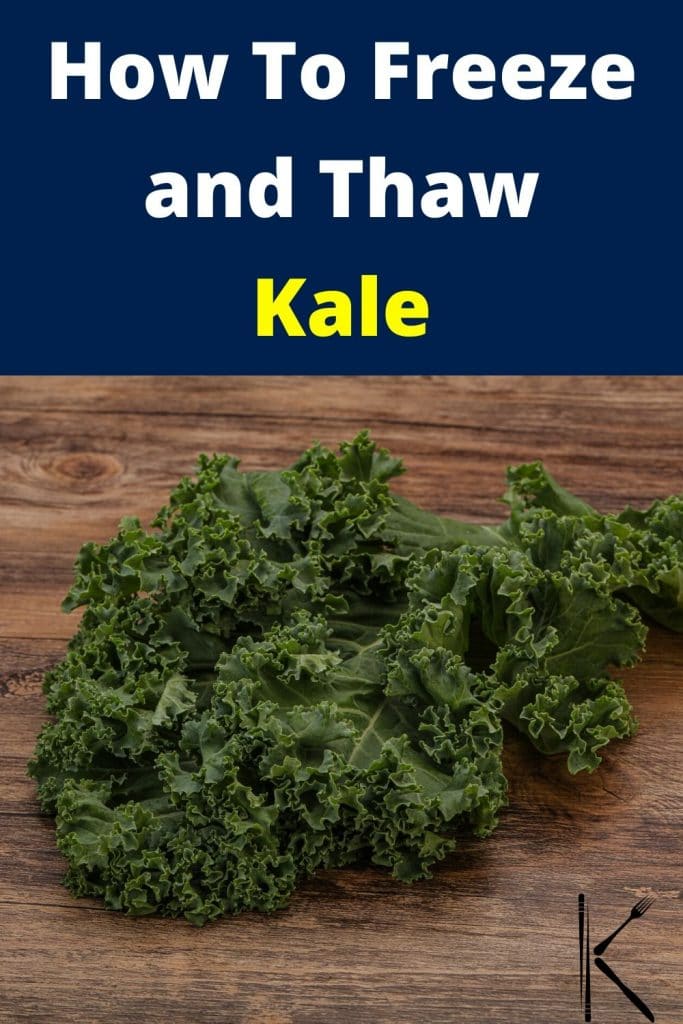In brief: Yes, sauerkraut can be frozen to preserve its tangy flavor and texture. It is best to freeze sauerkraut when fresh, as the freezing process can change texture and color.
Kale is a green leafy vegetable that is readily available in stores and easy to grow in your own veggie patch. Used in savory applications, kale is combined in salads, added to stir fries, soups, casseroles, eaten alone as a cooked side dish, kale chips, or blended into pesto and smoothies.
Kale is one of the key ingredients in Zuppa Toscana which is the perfect way to incorporate your greens into a hearty winter delight.
Whether your own harvest of fresh kale has been too much to use at once or you have a leftover bunch from the store, the hardy nature of these leafy greens makes them suitable for storing in the freezer for months if prepared correctly.
The process to preserve kale for long-term freezing is slightly labor-intensive, however, it will save you time and money in the future, and is well worth the extra effort for quick delicious recipes. Here you will find out exactly how to go about freezing kale for long-term preservation in the freezer.
Can Kale Be Frozen?
If you can’t use your stash of fresh kale before the bright green leaves start looking sad, the good news is that you can freeze kale to preserve it. Frozen kale keeps an excellent quality for cooking and for nutritious smoothies.
As with most fresh vegetables, it is recommended to blanch kale before freezing.
Blanching is the process of pre-treating the vegetables in boiling water in order to stop ripening enzymatic activity that eventually decays vegetables.
The naturally occurring enzymes will continue to function even when frozen, which will result in less vibrant color, poor texture, and a slightly bitter taste. Blanching kale also takes up less space in the freezer.
Unblanched kale that has been frozen is still good to eat, but the quality will just not be as vibrant as if it had been blanched prior to freezing.
Unblanched kale is best used in stews, soups, and casseroles where it will be blended in with a variety of other ingredients and flavors.
Kale plants are at their best when they are newly grown. That means that it is best to freeze kale leaves while still fresh. If you are growing your own kale, do not let the bunches sit in the garden for too long. Rather harvest and freeze them.
How To Freeze Kale
There are different ways in which you can go about the kale freezing process which will be largely dependent on how you are planning to use it in the future.
If you are not yet sure, it is advisable to blanch the kale before freezing as this will allow you to use the kale as a stand-alone side dish, or to incorporate it with other ingredients.
Follow the steps below for the best preservation of your greens in the freezer.
Step 1: Wash
Wash the kale thoroughly to remove any sand, chemicals, or bugs hiding in the leaves. To ensure it gets a good clean, you can wash kale in salt or vinegar water by filling a large bowl with cold water and adding one to 2 tablespoons of salt or vinegar to the water.
Soak the fresh leaves in the water for a few minutes and give them a good rinse.
Step 2: De-stem and Cut
Remove the leaves from the stems. Kale stems can be fibrous and hard to chew, although they do have their place in a stir-fry or to make pesto. If you plan to freeze the stems, keep them aside so you can store them separately from the leaves.
Once the leaves have been removed from the stems, cut them into smaller chunks if desired.
Step 3: Blanch
Note: If you are freezing the kale without blanching, you can skip this step and go straight to step 4. Keep in mind that you will need to use the kale within one to 2 months if you do not blanch it before freezing.
To blanch kale, heat a large pot of water on the stovetop until boiling. While the water is heating up, fill a separate bowl with ice water, ensuring that it is very cold.
Add kale into the bubbling water and let it boil for 2 minutes. Immediately remove it with a pair of tongs, or strain through a colander and place it straight into the ice water to stop the cooking process.
You do not want your kale to heat up so much that it wilts, the aim is just to kill the ripening enzymes for preservation purposes and then to stop the cooking process straight away by submerging it into the ice water.
Step 4: Dry
Once cold, remove the blanched kale from the ice bath and dry it in a salad spinner or pat it dry with a kitchen towel. Any extra moisture on the leaves will form crystals in the freezer which will damage the cell walls, causing the texture to breakdown.
Step 5: Pack
There are 3 different ways in which you can choose to pack your kale for freezing:
Option 1: Freezer Bags
Place the kale into resealable freezer bags, then press out as much air as possible and seal.
Option 2: Individual Portions
Lightly spray or grease a muffin tin and press down the desired size portions of kale to fill each muffin compartment. Place the muffin tin in the freezer until fully frozen. Remove the frozen kale rounds from the tin and place them in an air-tight freezer bag. Lightly press out the air before sealing the bag to prevent freezer burn.
Option 3: Blend
This method is ideal for using the kale in soups, smoothies, or sauces. Place the leaves in a blender and purée the kale. Add a bit of water if needed until you reach the desired consistency. Pour the kale purée into sprayed muffin tins and place the muffin tin in the freezer.
Once fully frozen, remove the rounds of kale purée from the tin and place them into a freezer bag. Squeeze out the air from the bag before sealing.
Tip: You can also use an ice-cube tray to make smaller portions ideal for adding to a green smoothie.
Step 6: Label and Freeze
Before you place the kale in the freezer, write the date of freezing on the packaging so you know how long it has been stored.
How To Thaw Frozen Kale
Frozen kale leaves will defrost quickly at room temperature or by submerging the sealed freezer bag in cool water.
If you are using the frozen veggies in small amounts to make a smoothie, or add to a cooked dish such as a casserole, soup, or curry, you can add it straight from frozen without thawing.
The kale will release some moisture as it defrosts during cooking so you may have to adjust the liquid content of your recipe or add a few minutes to the initial cooking time.
If you are adding the kale to a baked dish, quiche, or batter, the best way to use it is to defrost it first. Drain off excess moisture and then add it to the rest of the ingredients as the excess liquid will ruin the consistency of the batter.
Types of Kale
Kale is part of the cabbage family and is distinguished by its dark green and chunky appearance. It is grown for its nutrient-rich large leaves, however, the slightly woody stem can also be eaten if prepared accordingly. Kale comes in a few varieties, each with its own distinct leafy features.
The four most popular and well-known kale types are as follows:
Curly Kale
Also known as green kale, this kale has bright green and very frilly leaves.
Dinosaur Kale
With large long and flat dark-green leaves and a crinkled texture, this type of kale is also known as Tuscan, black, or Lacinato kale.
Red Kale
True to its name, red, or Red Russian kale has red or purple stems with frilly leaves.
Baby Kale
Baby kale leaves are smaller and lighter than regular kale. They’re ideal for raw salads.
FAQs
Conclusion
Keeping kale prepared and frozen will save you a lot of time and food-waste (i.e. money) in the long run. Its an easy way to prolong the life of your kale yield and make your favorite recipes with minimal prep time. If blanched before freezing, it can be kept for up to a year in the freezer.
Getting your greens couldn’t be easier. Simply grab a bag of kale from the freezer and add it to your healthy recipes.
Up Next: How To Freeze Lettuce

Image by depositphotos/AndreySt









